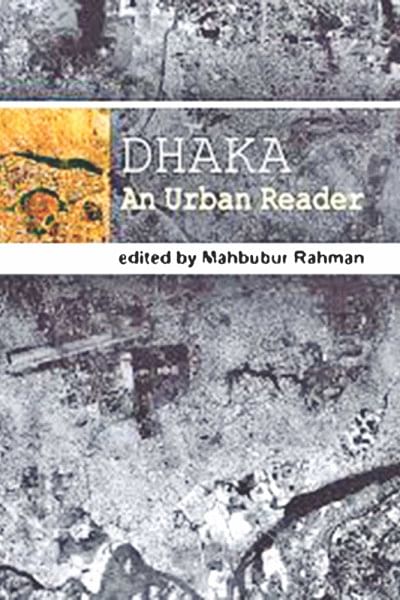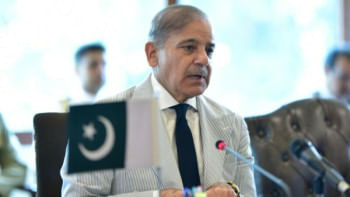Delightful deliberations on Dhaka

Any book or journal on or about Dhaka would immediately draw the attention and interest of people who were born in this 'impossible' city and who continue to live here despite the daily dose of swearing and grumbling. It is a kind of love-hate relationship for which despite every New Year's resolution of saying good-by to this "God forsaken" city, people unpack at the last moment and stay on. Dhaka is witness to many historical and historic events – tragic, tempestuous and thrilling, all at the same time. This is the theatre where the Language Movement of 1952 was staged. And this is the theatre where Bangabandhu Sheikh Mujibur Rahman gave the clarion call for fight for freedom and this is where the surrender of the Pakistani defeated forces had taken place in 1971. It would indeed take many more volumes like this book to chronicle the events of the past 400 plus years of this city.
However, Dhaka-An Urban Reader published by University Press Limited is not about the past but the present. This book presents some of the contemporary issues, which may not have been discussed before, from an urban design and planning perspective.
The book is a "compilation of ten essays by urban experts who focus on contemporary issues including the historical evolution of the built environment, cultural spaces, adaptation, urbanism, livability and urban design and planning." It is a well researched book indeed where a reader would find answers to many of his queries he had been searching for. In fact a keen reader would discover many new aspects about Dhaka hitherto unknown to him.
Let us take a look inside. Editor Mahbubur Rahman tells us that "Dhaka, one of the world's mega-cities and a major urban conglomeration in the region, came into prominence 400 years ago by becoming a capital city. Ever since, it has seen ups and downs in its fortune, created mainly by political and associated socio-economic factors. Yet, it has a rich history and culture. What does the future hold for Dhaka, endowed with natural topographical features? With 15 million people, relentless traffic, environmental hazards, and limited respect for the rule of law, Dhaka portrays a hopeless scenario. What should the authority, building and environmental professionals, and the citizens do in this context?
Mahbubur Rahman writes: "Devoid of the input of social or economic planners, environment professionals and urban designers, planning exercises in Dhaka have been limited to land use and pattern of transport routes, instead of being innovative, less regulatory, and more entrepreneurial and participatory. Plans are often made on questionable bases, sometimes even to ligitimise projects preferred by vested quarters. As Owens and Cowell (2002) and Sagoff (2007) observed, planners are challenged by the economic, environmental, and socio-cultural dimensions of sustainability; this involves making tradeoffs between alternative costs, locations, opportunities, etc. in order to achieve a sustainable urban future. There have been several plans for Dhaka in the last hundred years; none of these plans, which were motivated by Western ideals, have been fully implemented. Actions are executed on ad-hoc basis, and more often than not by bypassing the Plans. As a result, not all decisions have been made with the best interest of society and environment in mind."
The chapter by Mowla discusses colonial planning and local tradition showing how the growth and development of Dhaka was influenced by different phases in its socio-political context with varying, often opposing, requirements and physical manifestations. "Colonisation disrupted the natural evolution of Dhaka, which was termed a rupture by Azim (1900); the emergent modern form could not solve many problems. By analysing and evaluating the colonial impact on Dhaka's morphology, Mowla found the use of Western methods and materials in restructuring traditional building trades to be undesirable. He urges framing planning within the local tradition, not Western parameters. Planners and city authorities now realise that good planning strategies are rooted in the communities. Thus, Mowla suggested taking mahalla and punchayet as the basis of developing a planning unit and a morphology."
In the next chapter, Ferdous and Rahman talk about still functioning traditional neighbourhoods, and two types of urban spaces that work as vibrant socio-cultural space that constitute the cultural heritage of the city. "The chapter focuses on the spatial dynamics of two distinct Hindu and Muslim areas that, growing naturally over centuries, remain viable cultural spaces. Despite a few interventions, the culture, traditions and physical properties of the indigenous city characterised by such areas have changed little. Such spaces, representing the values, history and culture of Old Dhaka, must be conserved."
Hafiz and others point out how Dhanmondi deteriorated due to over population, profit mongering developers, encroachment by non-residential entities and lack of good governance. "Though one aim of planning is to create livable and sustainable residential areas, Dhanmondi is currently far away from meeting such objectives. The chapter explains the reasons and the process of such deterioration, and studies and measures livability and sustainability of the area based on some indicators."
Nilufar and Khan talked on morphological transformation of Dhaka. They reflect on the role of private or community initiatives. "The chapter discusses how in time, the organic areas adjust to the city which the planned areas experience encroachments and changes in land use to adapt to various demands, leading them to appear unplanned as a result. According to them, planning needs to consider the organic character and inevitable encroachment, and guide future development by keeping in mind that the planned areas will undergo spatial and functional changes.
Shihabuddin Mahmud and Mahbubur Rahman discuss elaborately the mechanism of preservation of old buildings by transformation of the domestic spaces in old Dhaka. It gives emphasis on awareness building regarding heritage and preservation of old buildings.
Mahbubur Rahman considers the sixth chapter as one that talks about the gravest problems of Dhaka -- destitute migrants living inhuman lives. "She searches for alternative approaches within a constant eviction threat, and shows that the fabric and social organisation of Karail, the largest slum in Dhaka, are determined by a hegemonic power relationship that exploits the poor, and makes long-term planning difficult. The typical focus of such studies on urbanisation, organisations, livability, governance, and statistics, instead of social and cultural considerations, was found inadequate to illustrate the complex processes characterising a city like Dhaka and a settlement like Karail. Against the formal top-down way, informality originated from people's spontaneous initiatives, questioning the bias of the understanding on how space and social processes should function.
The chapter by Rahman and Ara "discusses the challenges and prospects of restructuring Dhaka and presents visions of making it livable by preserving its ecology and heritage, dominated by water. Unplanned urbanisation, ineffective development controls, encroachment, and environmental degradation severed Dhaka's historic relationship with water. The authors urge to address these issues creatively by recognising them in planning and development. However, they also identify that disregard for natural resources, urban context or community benefit by the sterile institutions, bureaucracy, mediocre consultants, and vested interest groups blocks the path towards Dhaka's progress.
Mahbubur Rahman feels that the chapter by Imon which talks about QOL indicator of sustainability showing the link between sustainability and urbanisation in the context of developing countries – is a topic not discussed before in the context of Dhaka. "He identifies that after environmentally-biased initial literatures on sustainable development neglected the issues of design and livability, recent works are paying more attention to all three dimensions of sustainability in a holistic framework. Imon demonstrates the link of livability to people's experiences and socio-cultural features of the place so that urban design can incorporate the needs of all segments of a society. To him Dhaka doesn't need to be a Vancouver to enhance the QOL, as the socio-cultural variances between the two cities are too wide to make any replication meaningful. He, like the other contributors of this book, emphasises that the urban design of Dhaka should first understand the traditions and culture of urban space usage by its residents."
The chapter by Mahmood and Rahman addresses the continuous process of change and adjustment of Old Dhaka houses against this backdrop, which is stripping the society and the city of its heritage and identity. Identifying the reasons and process of deterioration in houses under such changes, commercial pressure, and new demands, the chapter explores how transformation could accommodate poor migrants and workers. Adaptive reuse of traditional buildings is used to improve livability, promote identity and continuity of place, generate civic pride, and foster a sense of empowerment elsewhere in many cities; Dhaka too could follow suit.
Rashid and Rahman in the last chapter "advocate urban renewals using available resources that will make people's input in planning and good governance an imperative. Government having trust in participation can reform its agencies to be able to conserve and protect heritage better. Since low awareness of heritage in national and social life is more insurmountable than access to resources, the authors suggested involving the civil society and the NGOs in building awareness of heritage and rights and increasing participation."
Dhaka-An Urban Reader throws new light on the present situation that Dhaka is in and offers suggestions that could be adopted to make things better to some extent. Many experts feel the damage has been done to a great extent therefore it will require sincere and concerted efforts by all those who love this historic city. It is hoped that urban planners would take note of this book, read it, and look for answers that might help them solve some of the problems.
The reviewer is Special Supplements Editor,
The Daily Star. He can be reached: [email protected].

 For all latest news, follow The Daily Star's Google News channel.
For all latest news, follow The Daily Star's Google News channel. 



Comments